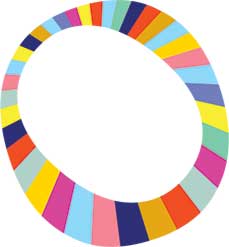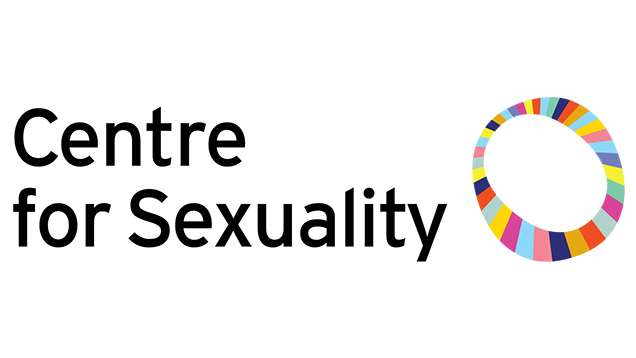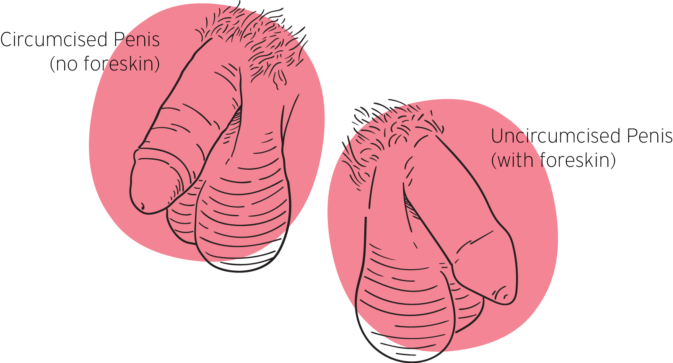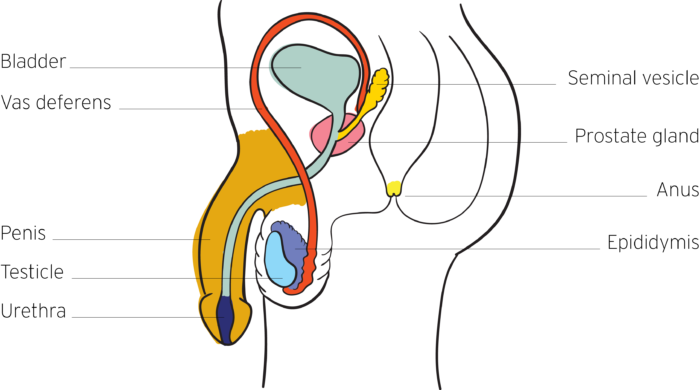External Anatomy
This part of the body is called the penis and the scrotum.
No two bodies look the same, so it’s perfectly normal if this isn’t exactly what someone’s body looks like. Penises can be of many shapes, sizes and complexions (colours). Some people may have had their foreskin removed through circumcision, while others may have had other types of surgeries involving their genitals for a variety of medical reasons. There are so many reasons why bodies look different, which is why we should try not to compare our bodies to others.
Penis
One organ on the outside of the body is called the penis, but the different parts of the penis have their own names. We’ll explain these different parts below. Both semen and urine typically leave the body through the penis, but never at the same time. During puberty, the penis will grow, and a person may notice that their penis curves to one side when erect. The size of the penis will be different for each person.
Pubic Hair
The hair that grows on and around the genitals during and after puberty. Pubic hair is different from person to person; it can be straight or curly, a lot or a little, and black, brown, blonde, white, red, auburn or grey. Some people shave their pubic hair, and some don’t.
Penis Shaft
The shaft is the part of the penis that runs from the body to the tip of the penis. When the penis is soft (flaccid), the skin is loose, stretchy and/or wrinkly. When it gets hard, the skin stretches out and becomes smoother.
Foreskin
The loose skin that protects the head of the penis. Some people have it removed by a doctor or skilled traditional provider when they are a baby, a child or an adult through a procedure called circumcision. Both uncircumcised and circumcised penises are normal.
Glans
The head of the penis, which is often slightly wider than the shaft. It has many nerve endings and is very sensitive to touch. The urethral opening is typically at the tip of the glans.
Urethral Opening
The opening where pre-ejaculate, semen, and pee (urine) leave the body.
Frenulum
The frenulum is underneath the penis, where the foreskin connects to the glans and feels similar to an elastic band, much like the frenulum under one’s tongue. This is a very sensitive area to touch.
Scrotum
The sac of skin and muscle just behind the penis. It holds and protects the testicles and keeps them at the right temperature to make and store sperm.
Perineum
The area between the scrotum and the anus. Some people find this area pleasurable and sensitive to touch.
Anus
The opening where poo (feces) leaves the body.
Internal Anatomy
These parts of the body are found inside the penis and the scrotum.

Testicles (also called testes)
The two ovoid glands that make sperm and hang inside the scrotum. The testicles are where the hormones testosterone, estrogen and progesterone are made, too. During puberty, the testicles will grow before the penis. It is normal for one testicle to hang lower than the other one.
Epididymis
Located on the backside of each testicle, this is where sperm mature and are stored. Mature sperm may leave the body during ejaculation. If someone does not ejaculate, the body will naturally re-absorb them.
Vas Deferens
The two tubes that carry sperm from the epididymides (plural form of epididymis) to the seminal vesicles and prostate gland.
Seminal Vesicles
The two small glands that add fluid to sperm to create semen.
Prostate Gland
A gland that adds fluid to sperm to create semen. Some people find it pleasurable to have the prostate stimulated. The prostate can be stimulated through the perineum and the rectum.
Cowper’s Gland
The glands which release a fluid called pre-ejaculate. Pre-ejaculate is released between the beginning of sexual excitement and ejaculation. Pre-ejaculate clears out any pee (urine) in the urethra so that sperm can leave the body in good condition.
Bladder
Where pee (urine) is stored until it leaves the body through the urethra.
Urethra
The tube that carries urine (pee), pre-ejaculate, and semen out of the body.
Corpus Cavernosum
Either of two tubes of spongy erectile tissue inside the shaft of the penis.
Fluids that leave the penis
Pre-Ejaculate
The fluid released by the Cowper’s gland between the beginning of sexual excitement and ejaculation. Pre-ejaculate clears out any pee (urine) in the urethra so that sperm can leave the body in good condition. Pre-ejaculate may contain sperm and bacteria or viruses that lead to STIs (Sexually Transmitted Infections).
Semen
Semen is a whitish fluid that leaves the body during ejaculation. Semen is a mix of sperm, sugars, acids, proteins, fats, minerals, and mucus.
Sperm
The reproductive cells made in the testicles. Someone will not make sperm until they have started puberty. New sperm are made all the time after puberty. If sperm get inside the vagina, they could join with an egg, and if implantation occurs in the uterus, this is how pregnancy happens.



